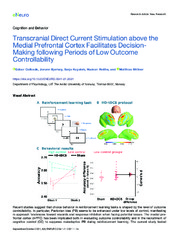| dc.contributor.author | Csifcsak, Gabor | |
| dc.contributor.author | Bjørkøy, Jorunn | |
| dc.contributor.author | Kuyateh, Sarjo | |
| dc.contributor.author | Reithe, Haakon | |
| dc.contributor.author | Mittner, Matthias | |
| dc.date.accessioned | 2021-09-28T08:03:06Z | |
| dc.date.available | 2021-09-28T08:03:06Z | |
| dc.date.issued | 2021-08-25 | |
| dc.description.abstract | Recent studies suggest that choice behavior in reinforcement learning tasks is shaped by the level of outcome controllability. In particular, Pavlovian bias (PB) seems to be enhanced under low levels of control, manifesting in approach tendencies toward rewards and response inhibition when facing potential losses. The medial prefrontal cortex (mPFC) has been implicated both in evaluating outcome controllability and in the recruitment of cognitive control (CC) to suppress maladaptive PB during reinforcement learning. The current study tested whether high-definition transcranial direct current stimulation (HD-tDCS) above the mPFC of healthy humans can influence PB, and counteract the previously documented, deleterious behavioral effects of low outcome controllability on decision-making. In a preregistered, between-group, double-blind study (N = 103 adults, both sexes), we tested the interaction between controllability and HD-tDCS on parameters of choice behavior in a Go/NoGo task. Relative to sham stimulation, HD-tDCS resulted in more robust performance improvement following reduced control, an effect that was more pronounced in appetitive trials. In addition, we found evidence for weaker PB when HD-tDCS was administered during low controllability over outcomes. Computational modeling revealed that parameter estimates of learning rate and choice randomness were modulated by controllability, HD-tDCS and their interaction. Overall, these results highlight the potential of our HD-tDCS protocol for interfering with choice arbitration under low levels of control, resulting in more adaptive behavior. | en_US |
| dc.identifier.citation | Csifcsak, Bjørkøy, Kuyateh, Reithe, Mittner. Transcranial Direct Current Stimulation above the Medial Prefrontal Cortex Facilitates Decision-Making following Periods of Low Outcome Controllability. eNeuro. 2021 | en_US |
| dc.identifier.cristinID | FRIDAID 1935156 | |
| dc.identifier.doi | 10.1523/ENEURO.0041-21.2021 | |
| dc.identifier.issn | 2373-2822 | |
| dc.identifier.uri | https://hdl.handle.net/10037/22678 | |
| dc.language.iso | eng | en_US |
| dc.publisher | Society for Neuroscience | en_US |
| dc.relation.journal | eNeuro | |
| dc.relation.projectID | Helse Nord RHF: PFP1237-15 | en_US |
| dc.rights.accessRights | openAccess | en_US |
| dc.rights.holder | Copyright 2021 The Author(s) | en_US |
| dc.subject | VDP::Social science: 200::Psychology: 260 | en_US |
| dc.subject | VDP::Samfunnsvitenskap: 200::Psykologi: 260 | en_US |
| dc.title | Transcranial Direct Current Stimulation above the Medial Prefrontal Cortex Facilitates Decision-Making following Periods of Low Outcome Controllability | en_US |
| dc.type.version | publishedVersion | en_US |
| dc.type | Journal article | en_US |
| dc.type | Tidsskriftartikkel | en_US |
| dc.type | Peer reviewed | en_US |


 English
English norsk
norsk